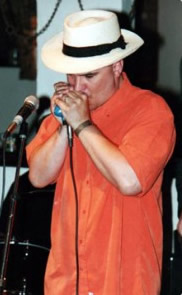Soloing
 So you joined a band and it’s your first rehearsal or maybe your first live show. At some point the rest of the guys look at you and nod: time for your first solo. What should you do? Don’t panic, Mr Mainwaring, you have plenty of options.
So you joined a band and it’s your first rehearsal or maybe your first live show. At some point the rest of the guys look at you and nod: time for your first solo. What should you do? Don’t panic, Mr Mainwaring, you have plenty of options.
Just pick a harp in the right key and go for it. Sometimes it’s the best option! Trust in your natural musical abilities.
Follow the melody
Pick up the melody line during the song, repeat and build on it during your solo break.
Follow the rhythm
Pick up the rhythm during the song and vamp over your solo break.
Follow the chord changes
Perhaps the most satisfying for you and the audience. Avoid retreating into trills and effects. Get musical. Play off draw 2 over the 1 chord. Use some blow notes over the 4 chord (try blow 2 or 4 and work off them). Find the patterns around draw 1 or 4 when playing over the 5 chord and the turnaround at the end of each bar sequence. Use light and shade – start quietly and build tension – especially in a slow blues. Work melodies, blues notes, moods, patterns, stops, licks and effects; but pay attention to the chord changes. The result is an accomplished musical contribution.
Keep it simple and use the space: less IS more
You don’t need to be the fastest, the loudest or the flashest. This is not a muscle-man competition, it’s an art. You have to contribute to what’s on the canvass, as part of a collective. The song, its message and its mood are the most important things. Get too busy and you ruin the effect. Leave space in what you play; weave around the existing mood, theme and chord structure. Build in your own feeling and passion… and take your time!
A word from Jerry Portnoy:
” ..you’ve got to make it interesting, you can’t have the same sound… I mean when I ran a band I always trained my band in dynamics; I don’t like songs played at the same dynamic level all the way through, you know, a lot of young bands don’t have a developed sense of dynamics and also a lot of them tend to sound very frantic when they play but I like that very lazy kinda thing which is what you get from the old timers; practically to a man… All the old timers and to me they all have the same language – take your time son, take your time, don’t get excited and I like that. To keep it interesting you have to .. I mean blues is a music of tension and release so the trick is knowing when to set the tension and resolution up, and so you have to build that tension until the listener can palpably feel that tension building and at the same time feels the need for it to resolve, and if you hold it and if you tease ’em with it – blues is an understatement music not an overstatement music – so you gotta kinda sneak up on them and finally they are just waiting for that release and if you just time it right and resolve it in a pertinent way it’s like fwoo… there’s a collective sigh in the audience and that’s what it’s about…
… simplicity is the most difficult thing to master and the normal process in developing that is.. it’s a winnowing-out process. In general you start out playing way too much, you’re overplaying and you’re throwing every friggin’ thing in and as you get experience you learn what to leave out, you learn how to use your space and to make the space work for you… you use the space just like you use notes… I mean the space is what lets what you play resonate in the listener and you have to leave that so that that note that you play registers and resonates in them and then you can run into the next section and build it or set something off against it – contrast, whatever- all that is experience, you can’t really do that overnight.
But what about John Popper, Sugar Blue, Jason Ricci and all the fast guys?
Jerry Portnoy: “You could destroy a guy like that with one well-placed note as far as I’m concerned. If you play the right note at the right time with the right sound out of it, that’s all you need.”
With thanks to the NHL and Steve Jennings for the Jerry Portnoy quotes
